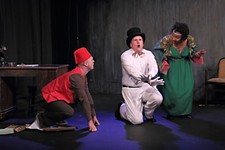The Music of Erica Zann
Local Arts Reviews
Reviewed by Robert Faires, Fri., May 31, 2002
The Music of Erica Zann: That Way Lies Madness
The Vortex,through June 8
Running Time: 1 hr
Fog and eerie piano music swirl through the sparsely lighted space, and in the midst of them we can see a woman tentatively stretching her hand toward the closed shutters of a circular window, then abruptly pulling it back. The stricken expression on her face and on the face of the woman with her -- her twin in appearance -- combined with the great gray, decaying flower petals radiating from the edges of the window, each one eight feet or more in length, suggest something ancient and horrific behind those shutters, something unspeakable that should remain on the other side of that barrier.
Entering The Music of Erica Zann is akin to falling into a fever dream, a hallucinatory state in which you're overwhelmed by strange visions and a palpable sense of anxiety and apprehension. In bringing H.P. Lovecraft's "The Music of Erich Zann" to the stage as a chamber opera, director Bonnie Cullum and her team of creators immerse us in a realm of shadows and discord and agitation. Edmund Pantuliano's score bristles with spiky dissonance, the musical equivalent of hairs on the back of the neck standing up, and it's performed by pianist Alex Krigsfeld and violinist Mariam Hembrook with a vigorous intensity that pricks at our ears. The greenish-bluish-purplish lighting by Jennifer Rogers and Natalie George casts shadows like bruises across the faces and bodies of the performers, who express fear and delight with wide, wild eyes. E. Dale Smith's William narrates the tale with the fixed stare and jittery look of a man who's been plucked from the sea after surviving a great disaster and seeing horrors beyond comprehension; he speaks to us from the far side of madness. Sandy Blue's Erica Zann, meanwhile, has yet to face it, but she's pulled toward it and conveys in both her face and voice an escalating terror and desperation. And dominating all of it visually is Ann Marie Gordon's immense ashen plant, suggesting something natural grown monstrously unnatural, like the creepy creeping terrors of The Day of the Triffids and Little Shop of Horrors. There are even smells that contribute to the mood: the fog seeds the environment with the sickly sweetness of overripe fruit. All the elements of the production unite to create an unsettling, unnerving unreality, and while it may not be an exact translation of Lovecraftian menace from the printed page, it does create something of the atmosphere that his prose evokes: the enveloping sense of dread.
As the title suggests, lyricist Mick D'Arcy and Pantoliano have made changes to Lovecraft's 1921 short story. The titular Zann has been transformed from a small old man with a "grotesque, satyrlike face and nearly bald head" into a pair of young women, both strikingly attractive with flowing blond hair. The two represent different aspects of the musician and embody the internal tension in the character regarding the force outside the window. The narrator has become a heroin addict wallowing in his habit who finds his cravings for the drug soothed by the unearthly music coming from Zann's garret room in the boarding house where he's been lured by the landlord Blandot, here a wild-eyed satyr with a limp (Scott Swanson's leering relish mixing sinister Dickensian villainy and gleeful Brechtian depravity).
These liberties were taken in the name of erecting a dramatic structure for Lovecraft's atmospheric but slight little tale, but the essence of the story remains: The narrator is inexplicably drawn to the strange melodies he hears, and the person responsible for those melodies is similarly drawn to a mysterious window and what lies beyond it. Drawing too close to the object of their fascination proves their undoing. In a sense, it is a story about that which is forbidden and the consequences of trying to possess it, a descendant of literally the oldest story in the book: that cautionary tale about an apple in a garden. But here the fruit is rotten with decay, and one bite is enough to send you into the mouth of madness.










